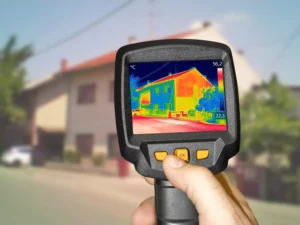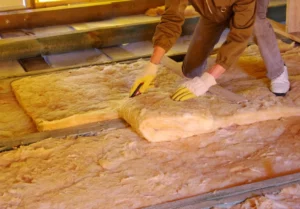
Thermal bridging is a phenomenon that can have a significant impact on your environment. Understanding how it works and its effects is crucial for addressing any issues that may arise. In this comprehensive guide, we will explore the concept of thermal bridging, uncover its hidden consequences, and discuss the role of insulation in combating it.
Thermal bridging occurs when a conductive material provides a path for heat to flow through an otherwise insulated part of a building. This can happen when materials such as metal or concrete act as thermal conductors, allowing heat to transfer from the warm side to the cold side of a building envelope.
Imagine a scenario where you are inside a well-insulated room on a cold winter day. You have turned up the heat to keep yourself warm, but as you walk closer to the window, you suddenly feel a chill. This is a classic example of thermal bridging. The cold air outside is infiltrating through the window frame, which acts as a thermal bridge, bypassing the insulation and creating a temperature difference.
As a result of thermal bridging, the temperature of the affected areas can differ significantly from the surrounding space. This temperature difference can lead to various issues, including discomfort, condensation, and even structural damage.
Let's delve deeper into the consequences of thermal bridging and explore its hidden effects.

One of the hidden consequences of thermal bridging is the reduction in energy efficiency. When heat can easily escape or enter a building, it can significantly affect the overall energy consumption. This means higher heating and cooling costs, as well as an increased carbon footprint.
Consider a poorly insulated building with multiple thermal bridges. The heat loss through these bridges can account for a substantial portion of the total energy consumption. This not only puts a strain on your wallet but also contributes to environmental degradation.

In addition to energy efficiency, thermal bridging also impacts indoor comfort. Cold spots near windows or other bridging areas can lead to discomfort, as temperature variations make it difficult to maintain a consistent and pleasant environment.
Imagine sitting near a window in a room with poor insulation. Despite the heating system working diligently, you still feel a draft and struggle to stay warm. This discomfort can affect your productivity and overall well-being.
Now that we understand the hidden consequences, let's explore how insulation can combat thermal bridging.
Insulation plays a crucial role in minimizing the effects of thermal bridging. By providing a barrier between the conductive materials and the interior space, insulation helps reduce heat transfer and maintain a more comfortable temperature inside.
When choosing insulation, it is essential to consider not only its thermal resistance but also its ability to address thermal bridging. Insulation materials with low thermal conductivity, such as mineral wool or spray foam, are particularly effective at combating this issue.
Imagine retrofitting your poorly insulated building with high-quality insulation. The insulation acts as a shield, preventing heat from escaping through thermal bridges. As a result, you experience improved energy efficiency, reduced heating and cooling costs, and a more comfortable living or working environment.
Furthermore, insulation can be strategically placed to minimize thermal bridging. By identifying and addressing potential bridging areas, such as window frames or structural connections, insulation can effectively break the thermal path and ensure a more uniform temperature distribution.
In conclusion, thermal bridging is a significant concern in building design and energy efficiency. Understanding its effects and hidden consequences allows us to make informed decisions when it comes to insulation and building materials. By combating thermal bridging through proper insulation, we can create more sustainable, comfortable, and energy-efficient spaces.

Thermal bridging is a phenomenon that occurs when there is a break in the continuity of insulation, allowing heat to escape or enter a building more easily. This can have a significant impact on energy efficiency, resulting in increased demand for heating or cooling and higher energy consumption. Not only does this have financial implications, but it also contributes to carbon emissions and environmental degradation.
When heat is allowed to escape through thermal bridging, it not only increases energy consumption but also affects the comfort levels within a building. Cold spots can form near these thermal bridges, leading to discomfort for occupants. Additionally, condensation can occur on these colder surfaces, potentially leading to moisture-related issues such as mold growth and structural damage.
Thermal bridging has a direct impact on the energy efficiency of a building. By allowing heat to escape or enter more easily, it disrupts the thermal envelope and reduces the effectiveness of insulation. This means that more energy is required to maintain a comfortable indoor temperature, leading to higher energy bills and increased reliance on heating or cooling systems.
Furthermore, the increased energy consumption associated with thermal bridging contributes to greenhouse gas emissions. These emissions are a leading cause of global warming and climate change, making it crucial to address thermal bridging as part of efforts to reduce our carbon footprint and create a more sustainable future.
The environmental impact of thermal bridging goes beyond energy consumption and greenhouse gas emissions. By increasing the demand for heating and cooling, thermal bridging puts additional strain on natural resources. The extraction, production, and transportation of fossil fuels used for energy generation contribute to air and water pollution, habitat destruction, and other negative environmental effects.
Moreover, the increased energy consumption associated with thermal bridging exacerbates the depletion of finite resources such as coal, oil, and natural gas. These resources are not only non-renewable but also have significant environmental and social impacts throughout their lifecycle.
To address thermal bridging and improve energy efficiency, there are various strategies that can be employed in building design and construction.
One approach is to incorporate continuous insulation throughout the building envelope, ensuring that there are no gaps or breaks in the insulation layer. This helps to maintain the thermal envelope and minimize heat transfer through thermal bridging.
In addition to continuous insulation, the use of thermally broken materials and the implementation of thermal breaks in construction can help disrupt the flow of heat through conductive materials. These breaks create a barrier, reducing the transfer of heat and minimizing thermal bridging.
Furthermore, improving the overall design of the building and considering factors such as window placement and orientation can also help minimize thermal bridging. By strategically positioning windows and incorporating shading devices, it is possible to optimize natural light and passive solar gain while minimizing heat loss or gain through thermal bridging.
By adopting these strategies and incorporating energy-efficient measures, it is possible to mitigate the impact of thermal bridging on energy consumption, reduce carbon emissions, and create more comfortable and sustainable spaces.